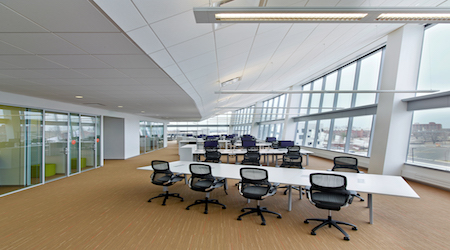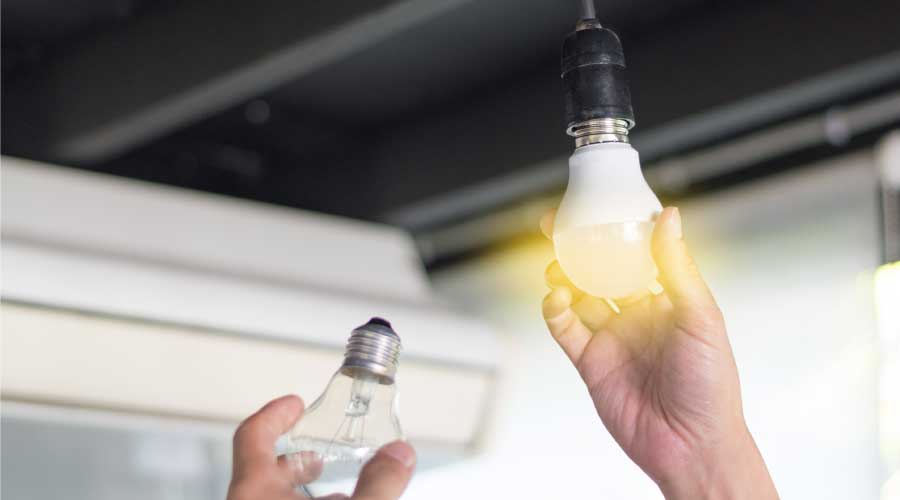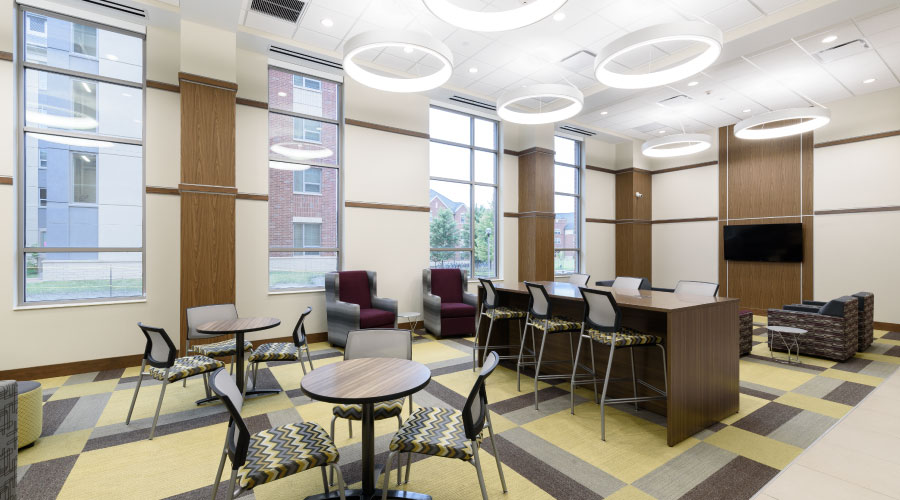Technology, Design Advances Are Driving High-Performance Lighting
Part 1 of a 3-part article on how efficiency is only the start in high-performance lighting.
Gains in technology, combined with advances in design practice, have made it entirely possible to create lighting systems that offer significant energy savings over designs that are merely code-compliant. But those savings don’t come at the expense of occupant satisfaction. In fact, high-performance lighting, provided it is well designed, can actually be better for occupants than older, less energy-efficient systems.
The move to high-performance lighting is being driven in part by the growing popularity of LEED certification. That, combined with the need to conserve energy, is leading a growing number of facility managers to take a close look at high-performance lighting systems.
While retrofitting older facilities for high-performance lighting is more challenging, specifying at least some high-performance lighting features in new construction is smart from a life-cycle standpoint and good for the environment.
Less Energy, Good Quality
High-performance lighting employs daylight harvesting, along with very efficient direct and indirect luminaires and lighting control systems. These control systems are capable of responding to daylighting and demand response needs, sensing occupancy, and allowing user-controlled dimming at an affordable price.
Lighting energy efficiency is measured in watts per square foot, which is also referred to as power density. Except for demanding lighting conditions often found in retail, medical, or some manufacturing operations, LEDs can light many indoor spaces for less than 0.5 watts per square foot, according to James R. Benya, principal illuminating engineer and lighting designer at Benya Burnett Consultancy. Just 40 years ago, many spaces used 3 or 4 watts per square foot, so high-performance lighting’s energy savings are substantial.
These gains in energy efficiency are accompanied by high levels of lighting quality. Provided issues such as avoiding glare and maintaining an average of 35 foot-candles per Illuminating Engineering Society (IES) recommendations are addressed, most experts agree that lighting quality can be as good or better with high-performance systems.
“There are a number of ways to have quality, energy-efficient lighting,” says Melanie Taylor, vice president of lighting design at WSP | Parsons Brinckerhoff. Reflecting light off ceilings and sharing light sources, for instance, are ways to shave wattage. In addition, she says, “high-performance lighting may have a lower ambient light level, with a higher level where tasks require it.”
Steven Mesh, principal at Lighting, Education & Design, says “it’s never necessary to sacrifice lighting quality for high-performance lighting.” He is quick to stress, however, that far more than just simple watts per square foot need to be factored into the final lighting solution.
In the design of lighting for an office space, for example, the lighting design has to go beyond daylighting elements such as windows and their location. Other important factors include the type of computer monitor and software being used in the space and how frequently, as well as the average age of occupants.
“Light distribution is more important than average foot-candle level,” says Mesh. He has often found that ceiling light may actually generate low levels at the desk level “but be perceived as fairly bright and perfectly fine.” Reducing the lighting decision to just making the targeted watts-per-square- foot levels “is not a good way to figure high-performance lighting out.”
A major factor that high-performance lighting designs have to take into account is glare. “Although LED lighting is incredible, its one major drawback is glare,” says Benya. The glare is produced because LEDs can be 1/20th as bright as the sun, he says. The glare of some naked LED high-bay luminaires actually “is severe to the point of causing ocular stress and even pain,” according to Benya.
Correcting that problem requires some form of shielding. “A good indoor LED luminaire will typically use a diffusing or mixing lens to prevent viewing the individual LED devices,” says Benya. “But diffusers and refractors reduce luminaire efficiency, as do shields such as shades or deflectors.”
Facility managers should be aware that not all LEDs are equal. Mesh cautions from experience that “some LEDs are not refined in terms of optical control.” He is working on a research project for a major headquarters in New York City that installed four different pendant LED systems. “We were very unpleasantly surprised, because we thought the state of development was further along in terms of outlight distribution.”
Going Beyond Code
Code-compliant lighting design meets the minimum requirements to control energy use. High-performance lighting systems take those requirements several steps further. Generally, high-performance lighting systems beat code requirements by a certain percentage, explains Taylor. They do so by integrating lighting, daylighting, and controls.
For example, daylight zone controls are required by the 2012 International Energy Conservation Code (IECC) and the ASHRAE Standard 90.1.
“However, not all daylight zone controls are required to be automatically responsive to the amount of daylight in the space,” explains Jonathan T. Hoyle, associate at The Lighting Practice. “The high-performance lighting system would include the necessary hardware for a complete daylight harvesting system. These systems go above and beyond the minimum requirements to fully embrace the intent of the energy savings outlined in the code books.”
It is entirely possible to achieve lighting power density levels considerably lower than current code limits, agrees Mesh. For example, he says the current lighting power density limit for new office lighting in California varies from 0.75 to 0.8 watts per square foot, depending on whether one is addressing the whole building or certain spaces within it. “In practice, it’s not unreasonable to achieve half of that,” says Mesh.
Harvesting Sunlight
Experts agree that even deep in urban jungles, high-performance lighting can use daylighting and dimming options.
“Very few of our urban areas in America are densely developed enough to prevent daylighting,” observes Benya. “Even then, the ‘human energy’ benefits of daylighting can still be realized by designing buildings that allow daylight access to most occupants.”
Mesh agrees, noting that even limited daylight penetration “will have a positive impact.”
To tap limited daylighting, white ceilings and light-colored upper walls help. Mary Ann Hay, principal at Syska Hennessy and its director of architectural lighting design, also suggests using lighter finishes around the perimeter and glass partitions to reduce overall lighting needs.
To be efficient, daylight harvesting also requires careful selection of glazing and shading systems. “A bad daylighting design causes thermal inefficiency,” says Benya. “The energy cost savings of free daylight can be wiped out by air conditioning costs.”
Conversely, well-designed daylighting offers another option, according to Benya. “If the daylighting is really good, you might consider less efficient (and less costly) electric lighting, because it will seldom be operating,” he notes.
Daylight harvesting is just one of several strategies employed in high-performance lighting. “A high-performance lighting system may include individual occupant controllability of luminaires, automatic shut-off controls, and dimming controls for more luminaires than what code requires,” notes Hoyle. “These controls all factor into how a lighting system can be best utilized to provide adequate levels of illumination but still be leveraged for maximum energy savings when not in use or when the function being performed does not require maximum light output.”
Lead photo caption: At GlaxoSmithKline’s Philadelphia Navy Yard offices, primarily fluorescent light sources with extensive daylight provide 30 foot-candles at the workplane with an overall lighting power density 26 percent better than the ASHRAE 90.1-2007 allowance. Photo courtesy of Francis Cauffman.
Related Topics:














